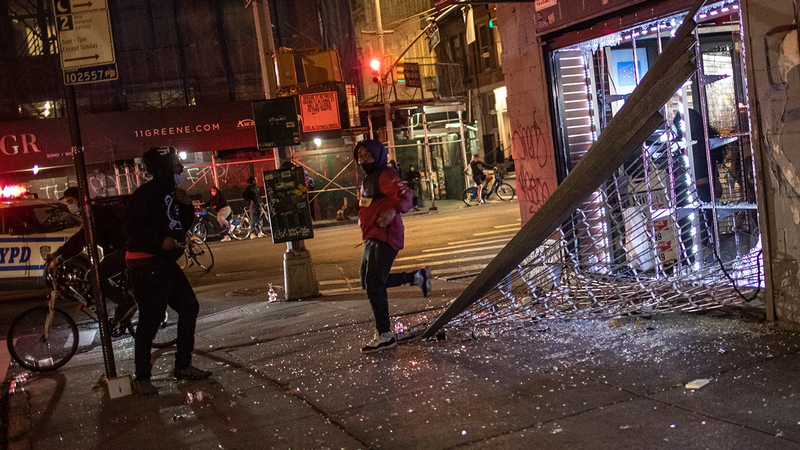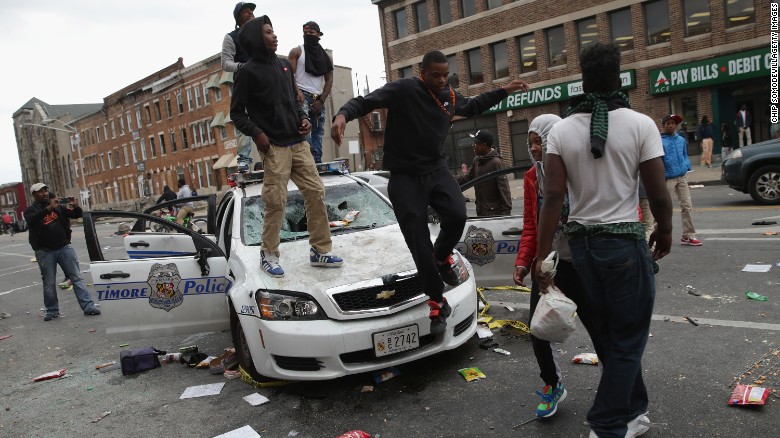The March Through the Institutions Brings Civil War at The New York Times

This week, The New York Times is not only publishing the news, but it is also the news--standing at the centre of controversy well worth watching. As it turns out, this development serves as a parable about massive worldview changes in the United States with urgent lessons about the culture.
Earlier this week, The New York Times ran an opinion piece by United States Senator Tom Cotton with the headline, “Tom Cotton: Send in the Troops.” Senator Cotton was elected to the United States Senate in 2015 after serving a term in the United States House of Representatives. Born in 1977, Thomas Bryant Cotton went to Harvard University where he earned his baccalaureate degree and then went on to graduate from Harvard Law School.
After graduating from Harvard Law, Tom Cotton decided to enter the military. He could have joined as a military lawyer, but he wanted to serve in the infantry. He eventually became a captain in the 506th Infantry Regiment of the 101st Airborne Division. His military career ran from 2005 – 2009, after which he served in the US Army Reserves. During his time in the armed forces, Tom Cotton was deployed to Afghanistan and Iraq and was a participant in Operation Iraqi Freedom, and he was awarded the Bronze Star medal. Representing the state of Arkansas, Senator Cotton serves strategically on the United States Senate Committee on Armed Services and on the Senate Select Committee on Intelligence.

All this to say, he is in a position to speak about troops and the United States military.
The New York Times is probably the most influential newspaper in the world. On June 3, it ran Senator Cotton’s opinion piece wherein he made a very simple point. Senator Cotton said that the rioting erupting around the nation, “plunged many American cities into anarchy, recalling the widespread violence of the 1960s.”
He pointed specifically to New York City, accusing Democratic Mayor Bill de Blasio of standing by, “While Midtown Manhattan descended into lawlessness, bands of looters roved the streets, smashing and emptying hundreds of businesses. Some even drove exotic cars; the riots were carnivals for the thrill-seeking rich as well as other criminal elements.” He also wrote about the dangers facing police officers who were, “encumbered by feckless politicians who have borne the brunt of the violence.”
Senator Cotton offered his assessment of these riots, stating: “Some elites have excused this orgy of violence in the spirit of radical chic, calling it an understandable response to the wrongful death of George Floyd. Those excuses are built on a revolting moral equivalence of rioters and looters to peaceful, law-abiding protesters. A majority who seek to protest peacefully shouldn’t be confused with bands of miscreants.”
In this, Senator Cotton carefully distinguished between protestors and rioters—between those who protest for a moral cause and those who loot and riot on the streets of America as agents of anarchy.

Then, at the main point of his article, Senator Cotton argued, “It’s past time to support local law enforcement with federal authority. Some governors have mobilized the National Guard, yet others refuse, and in some cases the rioters still outnumber the police and Guard combined. In these circumstances, the Insurrection Act authorizes the president to employ the military ‘or any other means’ in ‘cases of insurrection, or obstruction to the laws.’”
Anytime a United States Senator pens an op-ed for America’s most influential newspaper, we are looking at an important event. Senator Cotton’s article, however, took on a whole new significance in the aftermath of its publication—a significance that demands our attention and analysis.

Complaints emerged within The New York Times shortly after it ran Senator Cotton’s article. A significant number of employees of The New York Times—including employees who work in the editorial and reportorial staff—argued that by running the op-ed, The New York Times had endangered its black employees.
James Bennet, writing on behalf of the editorial board, ran a piece with the headline, “Why We Published the Tome Cotton Op-Ed.” Mr Bennet stated, “We published a piece yesterday that angered many readers, including many of my colleagues here at The Times. It was an argument by Senator Tom Cotton of Arkansas in favour of using federal troops to stop the looting and violence that accompanied some protests in recent days. I strongly oppose the idea of using federal troops. My position on this is reflected in that of The Times’s editorial board, which has criticized the president’s use of federal forces in Washington, D.C., fiercely defended the protesters as patriots, and condemned police brutality and called for thoroughgoing reforms.”

At this point, Mr Bennet clearly articulated his position as well as the political stance of the editorial board of The New York Times. He does not at all agree with the arguments made in Tom Cotton’s op-ed.
That being said, James Bennet also argued that Tom Cotton is a United States Senator and that the Senator’s argument is very much present and important for our society. The editorial board, in other words, was right to run the Senator’s column.
Nonetheless, many of the employees and staff members of The New York Times weren’t buying Mr Bennet’s argument. They wanted to have nothing to do with it. Indeed, some employees walked out, others indicated their protest and went public with it.
Other papers picked up the incident, including The Washington Post, which reported on the controversy at The New York Times. The headline of the article read, “Amid Staff Uproar, New York Times Publisher Defends Choice to Run Tom Cotton Op-ed Urging Military Incursion into US Cities.”

This article cited the fact that A.G. Sulzberger, publisher of The New York Times, stated that the New York paper prints a diversity of voices, including those opinions contrary to the stance of the editorial board. The New York Times, the publisher argued, airs divergent voices and opinions for the sake of public debate and discourse. The Washington Post article detailed the public rebuke of New York Times by its own staff members—rebukes that were made public on Twitter, with one employee tweeting: “Running this puts black New York Times staffers in danger.” In particular, many of The New York Times staffers objected to the words used by Senator Cotton when he called for an overwhelming show of force as necessary to, “restore order to our streets.”
One staffer who went public with her disapproval was Nikole Hannah-Jones, who won a Pulitzer for what became known as the 1619 Project. She stated, “I’ll probably get in trouble for this, but not to say something would be immoral as a black woman, as a journalist, and as an American. I am deeply ashamed that we ran this.”

The Washington Post further reports, “Roxane Gay, a contributing op-ed writer for The New York Times tweeted, ‘We are well served by robust and ideologically diverse public discourse that includes radical liberal and conservative voices. This is not that. [Senator Cotton’s] piece was inflammatory in endorsing military occupation as if the Constitution doesn’t exist.”
To be clear, asserting that Senator Cotton’s argument endorsed military occupation as if the Constitution didn’t exist is profound nonsense. It is a willful misrepresentation of Senator Cotton’s article. People of goodwill can disagree about whether or not the President should invoke the Insurrection Act. That is a legitimate debate. What is illegitimate, however, is labelling the Senator as blatantly discarding the Constitution. His arguments are not unconstitutional by any measure—indeed, previous presidents used the Insurrection Act to establish order on the streets – sometimes when civil rights activists were in danger.

This troubling turn of events at The New York Times serves as a parable, which indicates the erosion of the free exchange of ideas.
Make no mistake, this marks a massively important shift in our culture. Indeed, Bari Weiss, a staff editor at The New York Times, posted several tweets on Thursday afternoon. She wrote: “The civil war inside The New York Times between the (mostly young) wokes the (mostly 40+) liberals is the same one raging inside other publications and companies across the country. The dynamic is always the same. The Old Guard lives by a set of principles we can broadly call civil libertarianism. They assumed they shared that worldview with the young people they hired who called themselves liberals and progressives. But it was an incorrect assumption. The New Guard has a different worldview… They call it ‘safetyism,’ in which the right of people to feel emotionally and psychologically safe trumps what were previously considered core liberal values like free speech.”
After explaining the internal dynamics of The New York Times, she continued, “I’ve been mocked by many people over the past few years for writing about the campus culture wars. They told me it was a sideshow. But this was always why it mattered: The people who graduated from those campuses would rise to power inside key institutions and transform them. I’m in no way surprised by what has now exploded into public view. In a way, it’s oddly comforting: I feel less alone and less crazy trying to explain the dynamic to people. What I am shocked by is the speed. I thought it would take a few years, not a few weeks.”
Bari Weiss points to a generational conflict within The New York Times and she knows which side holds the future, namely, the young “woke” employees of America’s most influential paper. When they were hired, the leadership at The New York Times seems to have been blind to the fact that they were brining on radical progressives operating from a completely different worldview.
Interestingly, Weiss utilizes the word, “worldview.” Many on the left don’t want to use that word at all. Weiss, however, deploys this word, arguing that this is what lies at the heart of the rupture at The New York Times. A new group of people are ascending—people who reject the worldview that upholds, as Weiss states, “the liberal core principles [which] included the free expression of ideas.”
During the 1960s, the University of California at Berkeley stood at the center of the free speech movement. That was then, this is now. Now, the students and the younger faculty demand that the only speech allowed on the premises should be speech defined as
‘safe.’
Indeed, Bari Weiss points to this fundamental shift on American college and university campuses, arguing that this was no “side show,” but a real and present danger that has now caused a civil war at The New York Times.
Something far more urgent transcends this media controversy that demands the attention of Christians. It is a question about morality—and it is a question that takes us back to 1789.
I go back to 1789, not because that is the start of our constitutional order, but because of arguments made at that time by the philosopher John Stuart Mill. Mill asserted that the only adequate basis for morality should be the harm principle. In his book On Liberty, Mill stated, “The only purpose for which power can be rightfully exercised over any member of a civilized community against his will is to prevent harm to others.”
He made the case that if any law restricts human activity, the only justification for that law is the actual harm inflicted on another human being. The point is that Mill, who attempted to construct a new modern conception of liberty, labeled harm to others as the only moral principle. If you could not demonstrate harm to another, you could not restrict a person’s behavior or actions.
Mill’s arguments exerted enormous influence and showed up in a huge way at the end of the 20th century as the sexual revolution surged. The argument made by the sexual revolutionaries was that if you have two (or more) consenting adults engaging in any kind of sexual situation, there is no harm and it is therefore immoral to prohibit those kinds of activities. Indeed, these ideas culminated in 2015 with the Obergefell decision. During the oral arguments, it was asserted that if two men or two women wanted to get married to one another, where was the harm to any other person?
Those arguments continued to encompass the entire gambit of the sexual revolution, which demanded greater and greater sexual liberty in society. We are now seeing this sentiment expressed in the transgender movement.
Christians can never buy into the idea that the only valid barometer for the legitimacy of a law is the harm principle as espoused by John Stuart Mill. Christians believe, first of all, that something is wrong because a holy and righteous God has declared it to be wrong.
Moreover, Mill’s assertion opens the door, as it has in our day, to a definition of harm that is far too restrictive. Indeed, for Christians thinking about same-sex marriage, it is not up to us to assert that two men being married is in some way harmful to a heterosexual couple. Instead, we would argue that the institution of marriage is subverted and undermined—marriage is now relegated to a mere lifestyle choice or legal arrangement no longer understood as a covenantal union between a man and a woman.
We also argue that the harm that comes with same-sex marriage, especially to children, is the undermining of marriage itself. Same-sex marriage dismantles the most fundamental pillar of any civilization, namely, the institution of the family. Christians also understand that the issue of same-sex marriage began with the advent of no-fault divorce, easy divorce, and the redefinition of heterosexual morality. Society altered its legal codes, opening the door to so-called free sex and free love—the culture normalized fornication and adultery. All of these maneuvers and alterations to morality and the legal code brought enormous harm to civilization itself.
This principle of harm is what the young generation at The New York Times used as the foundation of their protest to Senator Cotton’s article. They argued that the publication of his op-ed endangered employees of The New York Times, particularly African-American employees.
The harm principle wedded to political ideology and identity politics is nearly universal now on the campuses of America’s colleges and universities—it has been psychologized and made into a sociological principle. Failure to validate an individual’s perceived identity, so the argument goes, is unsafe speech that will cause harm. If you will not meet the demand to accept and celebrate, for example, the transgender identity of a certain person, you will be labeled a threat—you will have no place to freely speak because your speech is now hate speech and harmful.
This is what Bari Weiss talked about when she noted a massive problem on college campuses. She said that there were those on the left who had said that what she observed was merely a “sideshow.”
This is no sideshow. This is the rise of identity politics that has now gripped a liberal paper like The New York Times. The old liberals thought they were hiring a band of new liberals. As it turns out, they are not liberals at all. Furthermore, the open embrace of identity politics and critical theory by The New York Times has now brought civil war within its own ranks.
Late Thursday, leaders of the Times surrendered to the revolutionaries they had hired. In a letter to the paper’s staff, released to the public, Publisher A. G. Sulzberger stated:
“It is clear many believe this piece fell outside of the realm of acceptability, representing dangerous commentary in an explosive moment that should not have found a home in The Times, even as a counterpoint to our own institutional view. I believe in the principle of openness to a range of opinions, even those we may disagree with, and this piece was published in that spirit. But it’s essential that we listen to and reflect on the concerns we’re hearing, as we would with any piece that is the subject of significant criticism. I will do so with an open mind.”
In other words, we surrender. Totally.
Christians must recognize the danger that this poses, not only to the broader culture but even to the church itself. This argument has already arisen and is being levied against evangelical Christianity: Christian missions, evangelism, and the core doctrinal commitments of the Christian faith are viewed as harmful and therefore dangerous. To espouse a traditional biblical understanding of gender and sexuality is to hold harmful, divisive, and retrograde positions that must not only be condemned but silenced.
The controversy at The New York Times is a picture of a larger societal campaign against classical liberalism and the commitment to free speech and the free expression of ideas. Indeed, most classical liberals could not get a hearing on a prestigious college campus without the threat of protest or arguments from the student body that the presence of such an individual on their campus should not be tolerated.
As predicted, this trend at American colleges and universities did not stay at the collegiate level. These ideas will transform every sector of American culture and society. Identity politics marks the ideological worldview of the coming generation of American leaders. As Bari Weiss said, “The people who graduated from those campuses would rise to power inside key institutions and transform them.”
It’s one thing for me to say that. It’s another thing entirely for Bari Weiss of the editorial board of The New York Times to make that kind of statement.
But she did—and her assessment is more correct than many are willing to realize.

